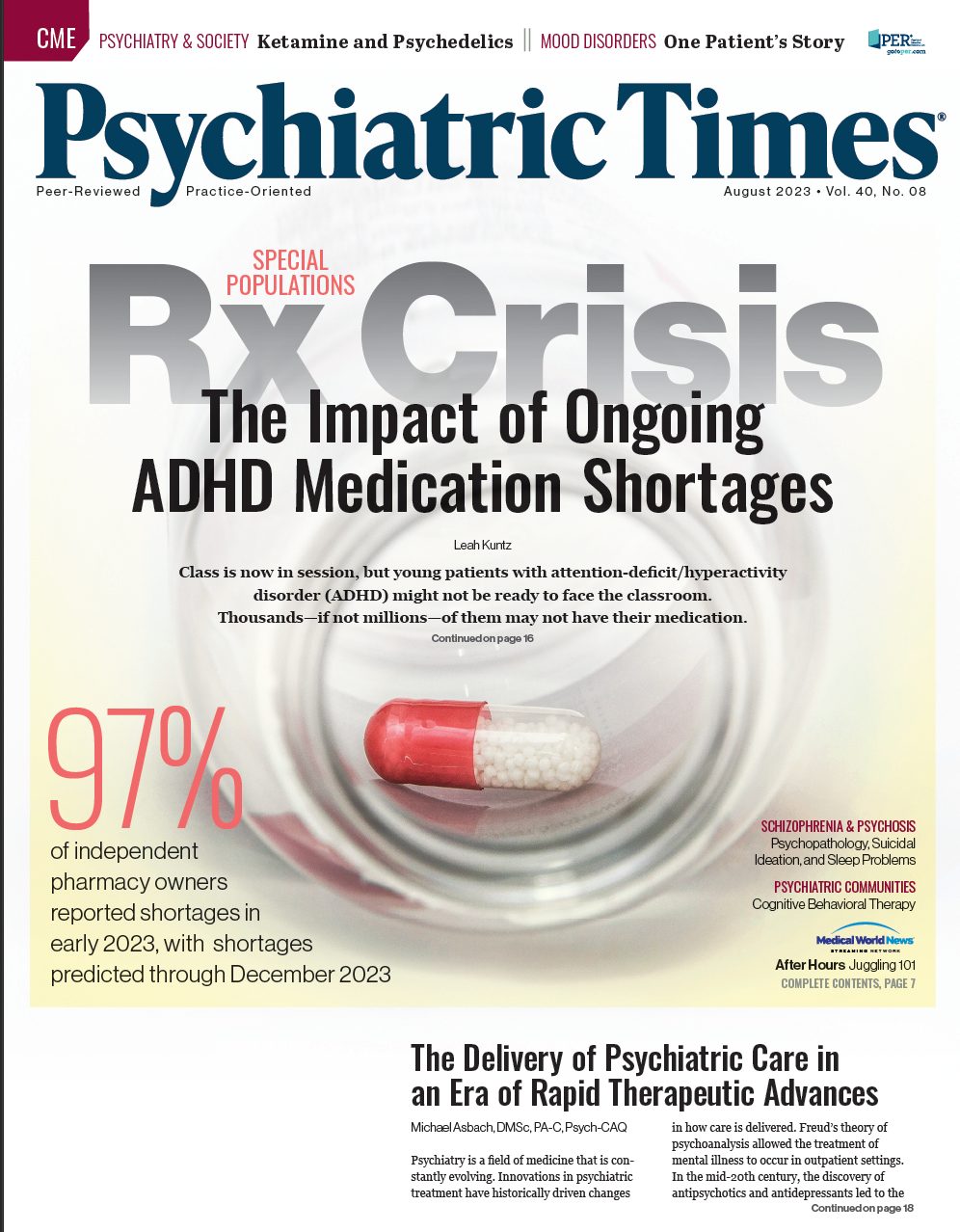Publication
Article
Psychiatric Times
Clinical Trial Explores Relationships Between Psychopathology, Suicidal Ideation, and Sleep Problems in First-Episode Psychosis
Author(s):
According to recent research, sleep problems were a common symptom in a large study of patients with first-episode psychosis.
highwaystarz/AdobeStock

CASE VIGNETTE
“Mr Deuce” is a 22-year-old male with no psychiatric history who presents to the emergency department with his family. He is a senior in college who has not been sleeping well. He complains of initial insomnia and says he has been taking NyQuil to help him sleep. According to his sister, the patient has exhibited delusional thinking, saying he is a superhero and that his college roommates are talking about him. He has had paranoid ideation that his room had been wiretapped. At admission, he told the interviewer that he was going to meet the president the next day. The patient also has periods in which speech is mostly incoherent. His laboratory study results, including a urine drug screening, were unremarkable. He received a diagnosis of a first episode of psychosis and was stabilized on risperidone 3 mg daily during an inpatient psychiatric hospitalization.
Insomnia is not part of the diagnostic criteria for psychotic disorders, but it is common in the clinical course of schizophrenia, affecting one-quarter to half of patients.1 Insomnia is strongly associated with suicidal ideation and behavior in psychiatric disorders, including schizophrenia.2 This association is relevant because there is a lifetime prevalence of 27% for suicide attempt3 and 5% for suicide death in the disorder.4 Several study results have also found associations between insomnia and greater symptom severity, including total, positive, and general psychopathology.2
The Study Exploration
Ayers et al5 examined associations between sleep problems, suicidal ideation, and psychopathology in a longitudinal study of a well-characterized sample of patients with early psychosis. Publicly available data from the National Institute of Mental Health Data Archive were obtained from the Recovery After an Initial Schizophrenia Episode (RAISE) Early Treatment Program early psychosis trial (NCT01321177; n = 404).6
Participants were those aged 15 to 40 years and had the presence of definite psychotic symptoms and evidence of DSM-IV diagnoses of either schizophrenia, schizoaffective disorder, schizophreniform disorder, brief psychotic disorder, or psychotic disorder not otherwise specified. All participants had experienced only 1 lifetime episode of psychosis (ie, individuals with a psychotic episode followed by full symptom remission and relapse to another psychotic episode were excluded) and had taken 6 months or less of lifetime antipsychotic medication. Participants were followed for 24 months.
In the present study, the authors investigated relationships between sleep problems in the past 2 to 4 weeks, suicidal ideation in the past 2 weeks, and psychopathology in the past week for participants from the RAISE trial at baseline and 6, 12, 18, and 24 months. Sleep problems at each time point were defined as the presence of terminal insomnia (assessed using the Calgary Depression Scale for Schizophrenia [CDSS] and/or endorsing sleep problems on the adverse effects scale). Hypersomnia and daytime sleepiness, which were addressed in separate questions, were excluded. Suicidal ideation at each time point was assessed using the CDSS and was dichotomized as present/absent. Psychopathology was measured with the Positive and Negative Syndrome Scale (PANSS) total and subscale scores at each time point. At baseline, 83.4% of participants were taking antipsychotic medication.
The authors investigated the association between sleep problems and suicidal ideation at each time point (baseline and 6, 12, 18, and 24 months) using logistic regression models. They also investigated baseline sleep problems as a predictor of suicidal ideation at 6, 12, 18, and 24 months. Finally, they investigated whether persistent sleep problems (“yes” vs “no” at all study visits) predicted suicidal ideation at any point during the study.
Age, sex, race, smoking status, education, body mass index (BMI), alcohol and cannabis use, PANSS total scores, and depressive symptoms (CDSS total score minus the insomnia and suicide items) were considered as potential confounding and/or moderating factors in the analyses. The authors also investigated associations between sleep problems and PANSS total and subscale scores in linear regression models, controlling for age, sex, race, smoking status, education, BMI, and substance use.
From the RAISE trial, 403 participants had data on baseline sleep problems and suicidal ideation. Similar data were also available for 291 participants at 6 months, 256 at 12 months, 221 at 18 months, and 205 at 24 months. The mean participant age was 23.5 years. Additionally, 72% were male, 54% were white, and 53% had a diagnosis of schizophrenia. Participants with sleep problems had higher depression (CDSS) scores vs those without sleep problems, with a large effect size (Cohen d, 0.80) and PANSS total, positive, and general scores with small to medium effect sizes (Cohen d, 0.29-0.32).
The prevalence of sleep problems was 57% at baseline and ranged from 40% to 48% at the follow-up visits. The prevalence of suicidal ideation was 15% at baseline and ranged from 5% to 11% at the follow-up visits. Five participants reported a suicide attempt during the study, with these participants also reporting concurrent sleep problems.
Sleep problems were associated with significant increased odds of suicidal ideation at baseline (odds ratio [OR], 2.25; 95% CI, 1.15-4.41; P = .018) and 18 months (OR, 4.64; 95% CI, 1.1-19.6; P = .037). These associations were no longer significant after controlling for depressive symptoms. Over the 24-month study, sleep problems at any point were associated with more than 3-fold increased odds of concurrent suicidal ideation (OR, 3.21; 95% CI, 1.45-7.14; P = .014). These associations were attenuated after controlling for depressive symptoms.
Baseline sleep problems did not predict suicidal ideation at any individual follow-up visit. However, participants with persistent sleep problems (“yes” at all visits; n = 50) were almost 14 times more likely to endorse suicidal ideation at least once during the study than those without sleep problems (“no” at all visits; n = 61) (prevalence of suicidal ideation, 50% vs 8%; OR, 13.8; 95% CI, 6.5-53.4; P < .001). This association remained significant after controlling for baseline depressive symptoms (OR, 7.7; 95% CI, 1.8-33.5; P = .007).
Baseline sleep problems were also a significant predictor of higher baseline PANSS total scores (β, 0.13; P = .010), positive subscale scores (β, 0.18, P < .001), and general subscale scores (β, 0.20, P < .001) but not negative subscale scores. Concurrent sleep problems were a significant predictor of PANSS total and general scores at 6, 12, 18, and 24 months and PANSS positive scores at 6, 12, and 18 months.
In linear regression analyses, after controlling for potential confounders, baseline sleep problems were associated with significantly greater levels of hallucinations, hostility, anxiety, guilt, tension, depression, impulse control, and active social avoidance at baseline (P ≤ .04 for each). The strength of these associations with most individual PANSS items was small (β, 0.11-0.16), although effects were slightly greater for hallucinations (β, 0.20), anxiety (β, 0.20), and depression (β, 0.28), which all remained significant after Bonferroni correction for multiple (23) comparisons (P < .001 for each).
Authors’ Conclusions
The authors concluded that sleep problems were a common symptom in a large study of patients with first-episode psychosis, affecting more than half of participants at baseline. Over a 2-year period, the prevalence of sleep problems ranged from 40% to 57%, and the prevalence of suicidal ideation ranged from 5% to 15%. After controlling for potential confounders, the authors drew several conclusions, which are listed in the Table.
Table. After Controlling for Potential Confounders, the Authors Concluded That:

Study strengths include the large sample size, the minimization of potential residual confounding by other illness and treatment factors in patients with early psychosis, the availability of longitudinal data over a 2-year period, and consideration of multiple potential confounding factors. Study limitations include self-reported measures of insomnia and sleep problems and suicidal thinking and behavior.
What Does It Mean?
These findings provide additional evidence that formal assessment and management of insomnia and sleep disturbance are relevant to the clinical care of patients with early psychosis as predictors of suicidal ideation and symptom severity. These findings also underscore the need for comprehensive suicide risk assessment in patients with early psychosis.
Dr Miller is a professor in the Department of Psychiatry and Health Behavior at Augusta University in Georgia. He is on the editorial board and serves as the schizophrenia section chief for Psychiatric Times. The author reports that he receives research support from Augusta University, the National Institute of Mental Health, and the Stanley Medical Research Institute.
References
1. Batalla-Martín D, Belzunegui-Eraso A, Miralles Garijo E, et al. Insomnia in schizophrenia patients: prevalence and quality of life. Int J Environ Res Public Health. 2020;17(4):1350.
2. Miller BJ, McCall WV. Meta-analysis of insomnia, suicide, and psychopathology in schizophrenia. Curr Opin Psychiatry. 2023;36(3):156-165.
3. Lu L, Dong M, Zhang L, et al. Prevalence of suicide attempts in individuals with schizophrenia: a meta-analysis of observational studies. Epidemiol Psychiatr Sci. 2019;29:e39.
4. Hor K, Taylor M. Suicide and schizophrenia: a systematic review of rates and risk factors. J Psychopharmacol. 2010;24(suppl 4):81-90.
5. Ayers N, McCall WV, Miller BJ. Sleep problems, suicidal ideation, and psychopathology in first-episode psychosis. Schizophr Bull. 2023;sbad045.
6. Kane JM, Schooler NR, Marcy P, et al. The RAISE early treatment program for first-episode psychosis: background, rationale, and study design. J Clin Psychiatry. 2015;76(3):240-246.

Newsletter
Receive trusted psychiatric news, expert analysis, and clinical insights — subscribe today to support your practice and your patients.





